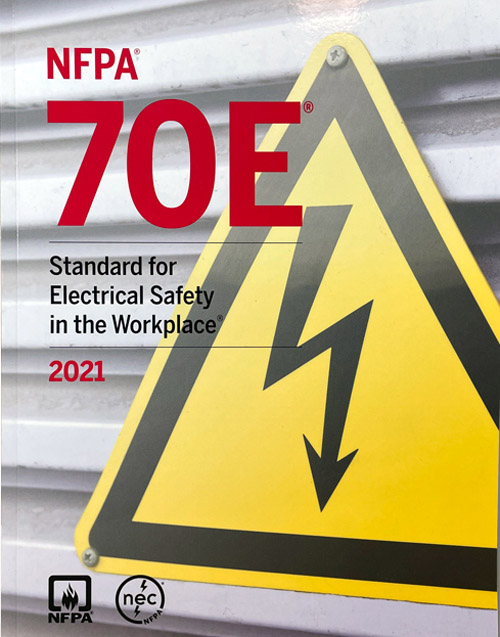
NFPA 70e Arc Flash Training
Our 12-Hour combined NFPA 70e Arc Flash Training and High Voltage Electrical Safety live online instructor-led course introduces front line qualified electrical workers to the electrical safety regulations found in NFPA 70E and explains the relationship between OSHA and NFPA 70E, the course moves through the standard, article by article, highlighting the important points in each.
Our NFPA 70e Arc Flash Training course is designed to help companies fulfill requirements of OSHA 29 CFR Part 1910, Subpart S Electrical and NFPA 70E® “Standard for Electrical Safety in the Workplace,” which requires this type of instructor-led training for anyone working with electrically energized equipment. This course includes changes in the latest version of NFPA 70E.
is instructed by one of North America's leading experts on Arc Flash and Arc Blast Hazard Protection and Mitigation. He will present new content NOT covered in our previous Arc Flash training courses and report on recent code revisions from NEC and NFPA, and the National Electrical Code. We teach general electrical safety principles and train electrical professionals on how to best develop an effective electrical safety program. Between these two elements, there will be plenty of examples and exercises for delegates to follow and then take back and apply to their electrical safety work practices.
Our NFPA 70e Arc Flash Training course will teach you how to:
Dangers such as shock, electrocution, and arc blast will always be present on the job, but proper training and safety strategies can minimize the likelihood of injuries and fatalities. NFPA 70E - Electrical Safety in the Workplace - covers the full range of electrical safety issues from work practices to maintenance, special equipment requirements, and installation. In fact, OSHA in the United States already bases its electrical safety mandates on the comprehensive information in this important Standard.
High Voltage Safety Training
This 6-Hour (one day course) live online instructor led course is designed for electrical maintenance personnel responsible for Medium Voltage/High Voltage electrical systems, supervisory and health and safety professionals who are responsible for overseeing high voltage electrical work.
Dynamic and highly concentrated, this High Voltage Safety Training course places maximum emphasis on safety when working on or near energized electrical equipment.
Students will learn the damage electricity can cause to the human body and understand the basic principles of safety in normal and abnormal conditions. They will also learn how to provide assistance in determining severity of potential exposure to Medium Voltage/High Votlage arc flash hazards, planning safe work practices and selecting proper personal protective equipment.
During this High Voltage Safety Training course you will learn to recognize and avoid electric shock in unsafe work areas. You will also learn correct approach distances. Upon completion, you will have a better understanding of proper voltage rated tools and the use of proper personal protection equipment. By educating workers on issues central to the safe performance of their everyday jobs, loss of life or serious injuries can be reduced and eliminated from your workplace. Your safety and the safety of your coworkers depend on it!
Review National and Provincial Medium Voltage/High Voltage electrical safety standards and regulations.
This One-Day High Voltage Safety Training Course Will Focus On The Following Areas:
Anyone whose job involves designing, reviewing, evaluating or installing electrical systems, including: designers, installers, engineers, electrical contractors, technicians, project managers, safety managers, inspectors, and others who are involved in hands-on electrical roles or maintenance planning.
NFPA 70e Arc Flash Training - Live Online Instructor-Led Course
DAY ONE
Electrical Hazards
Existing and Proposed Standards
Shock Hazards & Protection Strategies
Arc Flash Hazards & Protection Strategies
Arc Rated Personal Protective Equipment
Job Planning
Risk Assessment
Safety Related Work Practices
High Voltage Safety Training
Recognizing Electrical Safety Hazards - Where Do They Exist?
A detailed review of critical electrical safety hazards created by energized electrical equipment:
Resolving Electrical Safety Hazards
Objective: Determine the controls used to protect workers from all energy sources created in the workplace. Benefits of a safe workplace include fewer injuries, lower worker compensation costs, reduced service interruptions, greater protection of capital investment, and increased uptime. This section will provide you with a detailed blueprint that maximizes electrical safety and all the benefits it generates.
GENERAL ELECTRICAL SAFETY REQUIREMENTS
SWITCHING
This section of the course will instruct how to: interpret and use a single line diagram to write a switching sequence to safely isolate an electrical device for work; Validate existing operating orders and switching procedures; and Develop and maintain mandated documentation for all electrical equipment isolation and maintenance work.
WORKING ON HIGH VOLTAGE ELECTRICAL EQUIPMENT
WORKING ON DE-ENERGIZED HIGH VOLTAGE POWER SYSTEMS
WORKING CLOSE TO ENERGIZED HIGH VOLTAGE EQUIPMENT AND CONDUCTORS
COURSE TIMETABLE:
Start: 10 am Eastern Time
Finish: 4:30 pm Eastern Time
The registration fee to attend this live online training course is $399 + GST/HST.
Click Here to download a $50 discount coupon that you can apply toward the regular registration fee and pay only $349 + GST/HST
Register 3 delegates at full price $399, and get a 4th registration FREE!
Successful completion of this course qualifies delegates to receive a certificate of course completion with indicated CEUs.
CEUs are granted by the Engineering Institute of Canada. One CEU is equivalent to 10 professional development hours of instruction.
This course earns 1.2 CEUs.